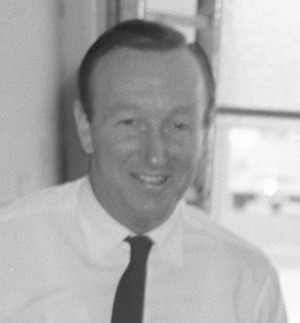Francis Farley facts for kids
Francis James Macdonald Farley (born October 13, 1920, died July 16, 2018) was a brilliant British scientist. He was elected a Fellow of the Royal Society in 1972, which is a very high honor for scientists in the UK. He was also a member of the Institute of Physics and an honorary fellow at Trinity College Dublin. Francis Farley studied at Clifton College and Clare College, Cambridge, earning his PhD from Cambridge in 1950.
Contents
A Scientist During Wartime
During World War II, Francis Farley used his scientific skills to help. He designed and built the first X-band microwave radar. This special radar helped direct large 15-inch guns at Dover, showing where the shells landed. He also invented a type of radar called clutter reference Doppler radar. This radar could see vehicles on land and was used during the war in Italy.
Post-War Contributions
After the war, Farley became a senior lecturer at Auckland University. In 1955, he was a delegate for New Zealand at a United Nations conference in Geneva. This meeting was about the "Peaceful Uses of Atomic Energy." Later that year, while working at Harwell, he measured how many neutrons were produced when plutonium split apart.
Unlocking Secrets of Tiny Particles
From 1957, Francis Farley worked at CERN, a famous research center in Switzerland. Here, he made some of his most important discoveries about tiny particles.
The Muon g-2 Experiments
Farley designed and measured something called the muon g-2 value. This is about the "wobble" of a particle called a muon. He did this in three experiments, inventing a special machine called a muon storage ring. These experiments helped scientists understand how muons behave. He also performed other accurate tests of special relativity at CERN, like measuring the muon's lifetime.
Farley played a leading role in these experiments. He continued to guide later measurements of the muon g-2 at other labs, like Brookhaven National Laboratory and Fermilab. These experiments involved hundreds of scientists and engineers.
Impact on Particle Physics
Francis Farley's work on the muon g-2 experiments was very important for particle physics. Each time the experiments were done with more accuracy, they revealed new physics. They showed that the muon is a particle that follows the Dirac equation and helped confirm theories like quantum electrodynamics, hadron physics, electroweak theory, and the Higgs mechanism.
These experiments have been crucial for the progress of particle physics theory. The most recent experiment at Fermilab continues to help scientists understand new particles. It helps to limit ideas like Supersymmetry and Dark Matter.
Later Innovations and Recognition
Francis Farley was not only interested in tiny particles. He also worked on new ways to create energy.
Wave Energy Development
In 1976, he started working on wave energy. He filed 14 patents for his ideas in this area. He was also a co-inventor of a device called the Anaconda wave energy device, which captures energy from ocean waves.
Awards and Academic Roles
In 1980, he won the Hughes Medal from the Royal Society. This award was given to him "for his super-accurate measurements of the muon magnetic moment." This work was a tough test for quantum electrodynamics and helped us understand the muon better.
From 1967 to 1982, he was the academic head of the Royal Military College of Science in Shrivenham. He was also a visiting professor at several universities, including Yale, University of Reading, University of New South Wales, and Southampton.
Contributions to Medicine
In 1986, Farley moved to France. There, he helped the Centre Antoine Lacassagne, a cancer hospital in Nice, install a special machine called a 65 MeV cyclotron. This machine is used for proton therapy, a type of cancer treatment. He designed the system that guides the proton beam to the patient. This system worked without changes for 23 years and treated over 3,000 patients for eye cancer with a high success rate of 95%.


